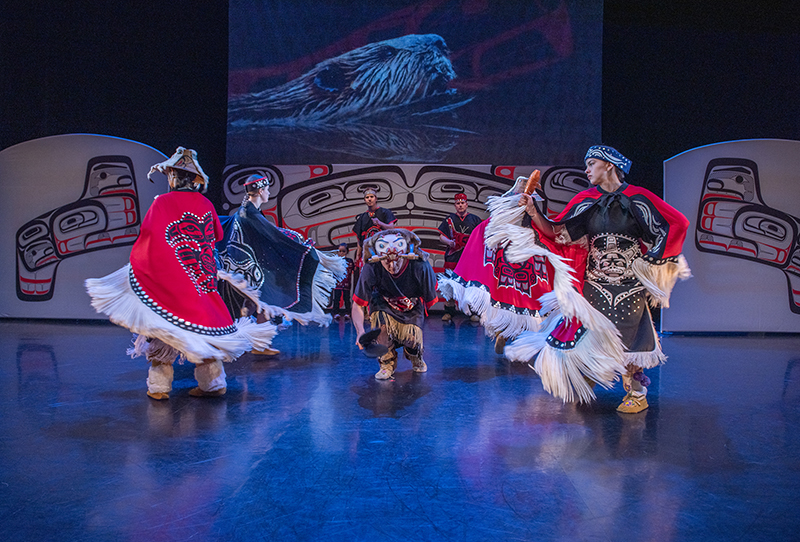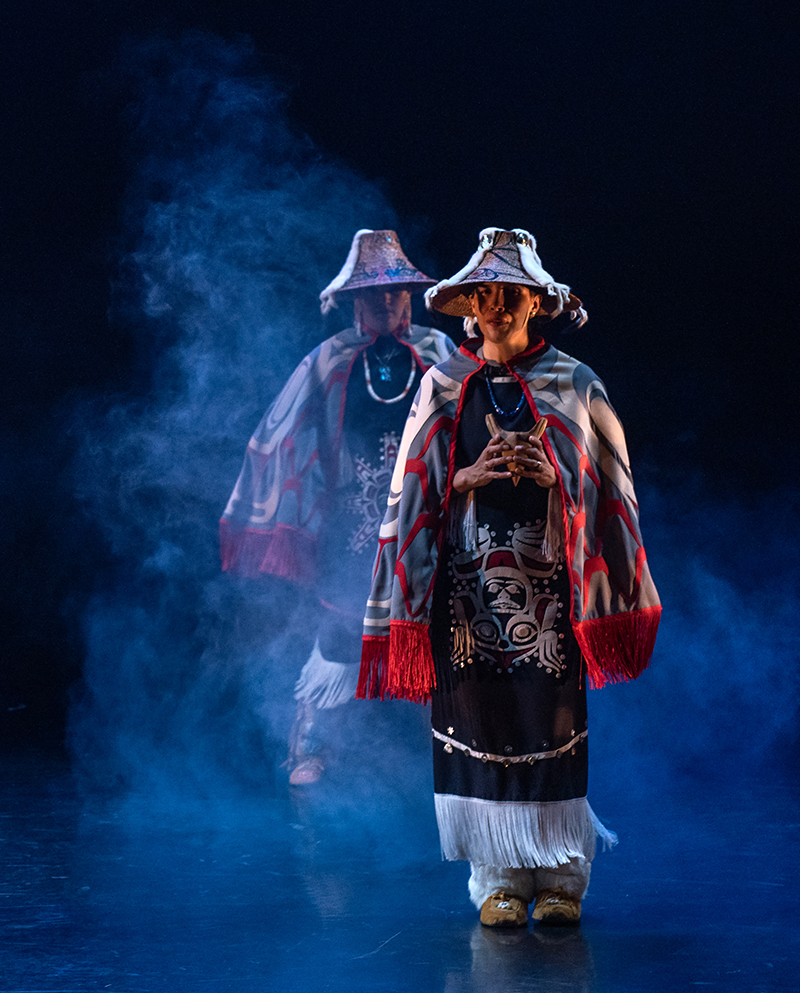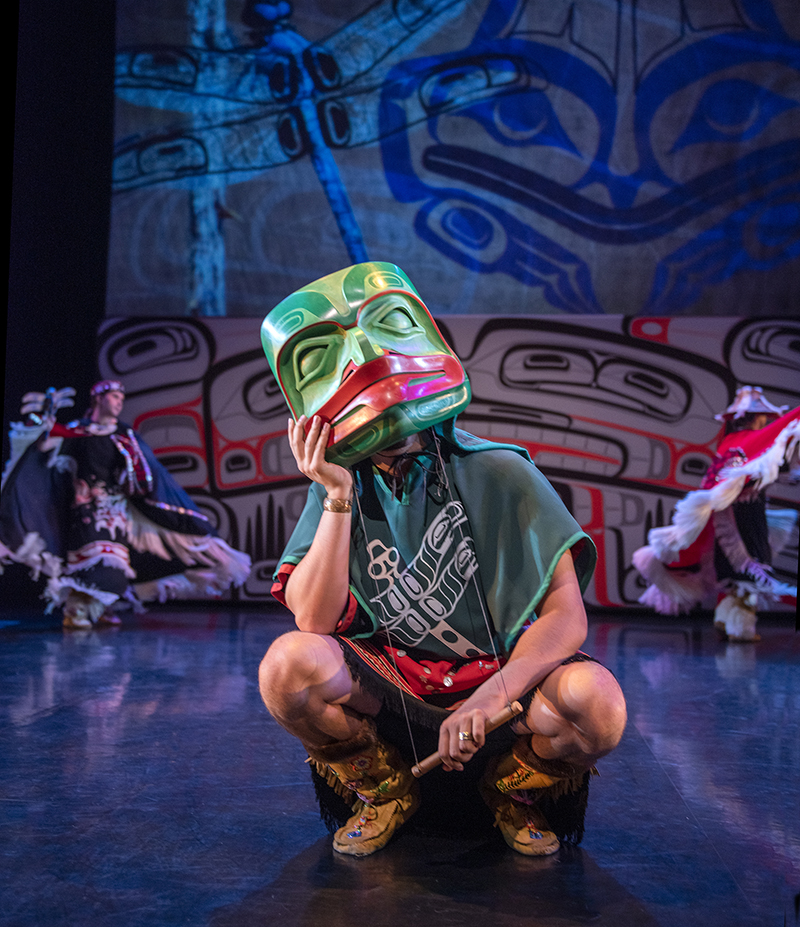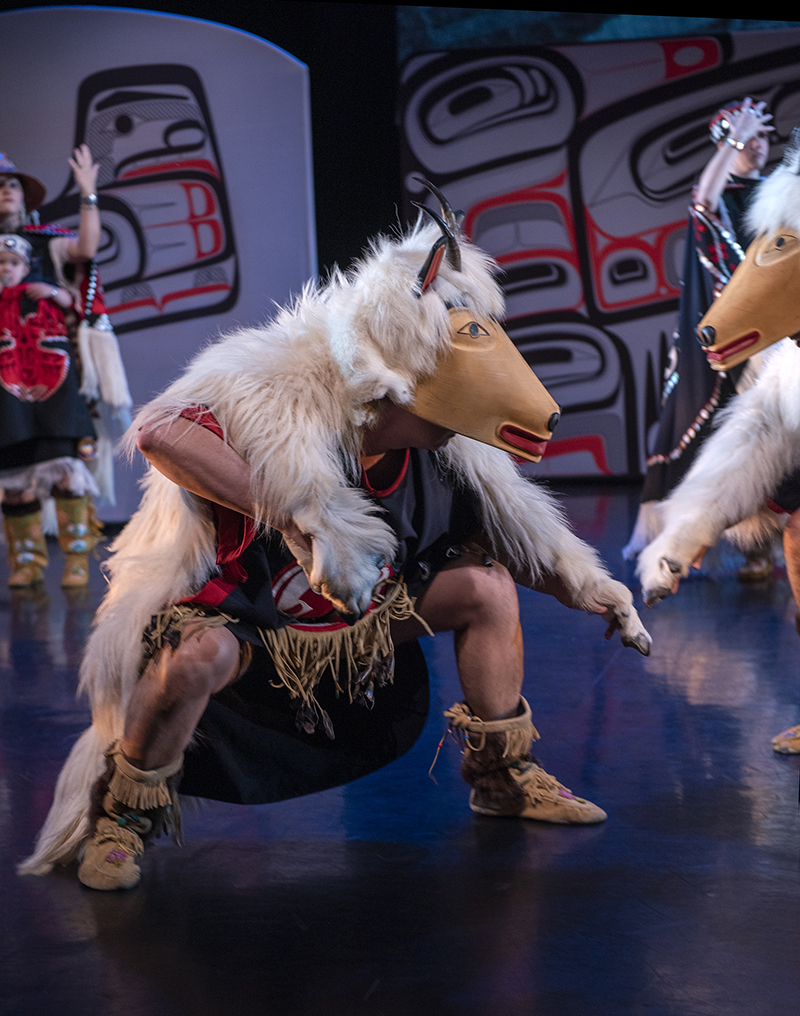Sovereignty in How We Express Ourselves
An Interview with Margaret Grenier, director of Dancers of Damelahamid
BY EMMALY WIEDERHOLT
Dancers of Damelahamid is an Indigenous dance company based in British Columbia, Canada, founded upon more than five decades of extensive song and dance revitalization. Executive and artistic director Margaret Grenier grew up with the songs and dances and has sought to contemporize the forms while maintaining their cultural legacy. She describes the history of the company and its current iteration as a touring company, as well as the Coastal Dance Festival that the company hosts and its role in strengthening Indigenous community and art forms.
Note: This interview was first published in Stance on Dance’s spring/summer 2024 print issue. To learn more, visit stanceondance.com/print-publication.
All photos from Dancers of Damelahamid’s production Spirit and Tradition. Photos by Chris Randle.

~~
How did Dancers of Damelahamid get started?
In the 1960s, the company started as a response to the lifting of the Potlatch Ban in 1951. [From 1884 to 1951, the Indigenous ceremony known as the Potlatch was banned by the federal government of Canada. The Potlatch is a traditional ceremony of the Indigenous Peoples of the Northwest Coast of British Columbia and the interior western subarctic.] My grandmother, Irene Harris, who was already an elder, saw the culture as being asleep, not lost. She began to train my parents, Chief Kenneth Harris and his wife Margaret Harris, who were the leaders of the Dancers of Damelahamid at the time. In our culture and tradition, dances are maintained through matrilineal lines. They tell histories that go all the way back to our origin of Damelahamid, which is our original city from our creation story. To share this practice as a performance was a big shift that was reflective of the time and the strong need for resurgence of the practices. Prior to the Potlatch Ban, the dances would have been shared within our feast halls.
I was the first generation to grow up with song and dance once again. The decision to bring dance into performance spaces established something I feel shapes my identity as an Indigenous person, connecting me to family, oral history, land, stories, and teachings. I began leadership in the early 2000s in response to seeing my parents get older. The practice needed to be carried forward. From there, I came to realize that it’s not my place to repeat the work of my parents or their generation. My place is to add my voice to the stories, to share contemporary perspectives, and in this way to not only be reflective of my own place in it but also to strengthen the link between their generation and my children’s generation. That has carried the company forward and transformed it. It’s intergenerational, and with each generation, there have been new social and cultural circumstances that shape and define who we are in a much longer narrative.
Who are the Dancers of Damelahamid?
Traditionally, the dances would be shared within family lineages, and different families would carry dances. That’s reflective of the regalia worn and the crafts on the regalia. The way to describe what happened throughout this process of dance revitalization going back to the 1960s was that it was a different set of circumstances. My family is quite privileged to have had a visionary like my grandmother. So much of our artistic practices were lost to many families and communities. That has pushed us in a way where guest artists have been invited to dance with our family. For those who are invited, it’s not through auditions, but through bringing others into the family, not just training in the songs and dances but also in the cultural contexts. The training becomes quite extensive. Those who come to dance with the family have become part of it, not actively dancing throughout their life but maintaining the relationship throughout their life. The dance itself has only been strengthened by that process because it was so close to being lost. It has taken a community that needs to be larger than immediate family relations.

How would you describe Dancers of Damelahamid’s performances for someone unfamiliar with them?
The work is placed within our ancestral dance forms. This comes from our Gitksan ancestry. When my father married my mother, she came from Cree ancestry, so that has been brought into our family as well. The contemporary perspectives that are being brought are those that speak to the struggles or challenges we face. I was taught that the whole purpose of dance was to live life in a way that honors our origins. The dances are created to also speak to the strengthening of the process we have undertaken.
For myself, for example, it was significant when my father passed in 2010. That’s when we stopped doing the ancestral dance he carried. The first production we did was us questioning the essence of this dance form. What does it mean to maintain this practice?
In 2012, we did our first contemporary production. It spoke to loss. For Indigenous people, there has been so much loss. It can be hard to know how to move forward, to have enough foundational grounding to be able to. It spoke to the process of going inside and finding myself and my voice. It felt like that dance was an offering to the healing process of loss and finding myself in a contemporary practice based in our ancestral dance and maintaining our movement vocabulary and structures.
Does Dancers of Damelahamid usually perform for Indigenous communities or more Western/white audiences?
When I was growing up in the dance, it was strongly based within the Indigenous communities of the Northwest Coast. Certainly, there are those who have come to watch and witness. That practice is what started the festival. The Coastal Dance Festival is what it’s now called, and it started again in 2008. Originally it was hosted by my parents. Although it has mixed audiences, it really is a platform to serve Indigenous artists and communities and inclusively bring others to come and witness.
It wasn’t until 2016 that things shifted for our company. We approached The Cultch, a theater in Vancouver, about a production we wanted to create, and were invited for the first time to do a residency and be part of their season. It was May 2016 when Flicker premiered at The Cultch. We brought that piece to the National Arts Centre and performed at the Canada Dance Festival. That was a significant shift. In numerous conversations approaching residencies prior, the response I would receive is that their mandate is to serve contemporary dance, so maybe collaborate with a contemporary dance company and then come back and reapply. We were the first Indigenous company to tour through several Canadian festivals and we shared the piece at a number of venues.
It really created an opening not just for our company, but also a shift in the place that Indigenous dance had within the genre of Western dance practices. It’s only been in the past seven years that we have had the opportunities we have had. We’ve experienced very new relationships with presenters. That speaks to a change that has happened in the field only recently.

What is Dancers of Damelahamid’s relationship to the Coastal Dance Festival?
We are the same family in terms of the Dancers of Damelahamid as a company and the hosts of the festival, but the Coastal Dance Festival is not about the Dancers of Damelahamid. It’s about the relationships with numerous other Indigenous dance artists. The festival restarted in 2008, when we were able to leverage support through the Cultural Olympiad. It would not have been possible without that funding. We began to build relationships with artists from the territories of other Indigenous groups in the area and throughout the coast. Artists will return to the festival year after year from Alaska, Vancouver Island, Northern British Columbia, and the Yukon. We’ve seen young people who have grown up in the festival who are now becoming emerging artists on their own. We’ve had the opportunity to host Indigenous artists from throughout Turtle Island and have developed relationships with Indigenous artists in Australia, New Zealand, Norway, and Sweden.
It’s not just about the community, but also about the strengthening of the art forms by the community coming together year after year, being inspired by one another, and providing a nurturing space for young people to grow up within. It’s a place for all ages to connect. For me, that’s what the festival has been and will always be. It’s about taking care of and providing a space that is constant and allows us to have our own sovereignty in how we express ourselves.
I understand that many Indigenous dances are not intended to be performed for outsiders’ eyes. Is this a navigation that Dancers of Damelahamid makes?
I think the answer to the question ties into the whole process of decolonization and finding our way forward as Indigenous people. The answer is different for every individual and community. For myself, I’ve had my own journey to navigate and listen to different voices in different communities. There’s never true consistency, never black and white; there’s always a middle area to navigate. For myself, it has come down to being attentive to the training I received; being attentive to what I have been taught as the reasons why we dance; being attentive to what we hope to cultivate, not just for my children’s children, but how that can ripple out as well; and offering what I feel can help bring healing and strengthening to a history that is still so broken and deeply fractured. The answer will always shift and transform. I’m finding my way through this question constantly. My grandmother took a huge artistic risk. We’re too fragile to be too careful or not careful enough. All I can do is navigate it in a way that answers my own questions honestly and honors all the voices. I don’t think we’re in a place where we can really say any choices are wrong.

Are there problematic assumptions that funders or presenters have made about Indigenous dance? Are they holding the space for Indigenous dance in the best-informed way?
It comes down to not knowing. The hard part is you make yourself vulnerable in all those places. The difference between being in an Indigenous community versus a non-Indigenous community is it can be more supportive when people really see the reason for why you’re doing something and can honor that. There is so much to learn still within the diversity of Indigenous dances and the process of reconciliation. It is a difficult path. It requires a lot of giving on the side of Indigenous artists and requires us to be open and give our stories in a way that can sometimes feel very held and sometimes feel misunderstood.
This dance form that I practice goes back literally thousands of years. This is a practice with deep longevity. Dance was upheld as our most important form of cultural wealth. We fought so hard to carry it forward. I certainly will always work my hardest and do my best to honor that legacy, and that is all I can hope to do, but it’s not always what is understood. That can make people uncomfortable. The hardest part is when we find those gaps.
What’s next for Dancers of Damelahamid?
We have an upcoming production that has been delayed because of the pandemic. It will premier in October 2024, followed by a national tour. During the pandemic, my mother passed, and she was the last in my immediate family in terms of the elders of her generation to guide us. This next piece, Raven Mother, honors and speaks to these women who were the stronghold to ensure we have dance today. It also speaks to the transformation of the practice from generation to generation. I see it in the young women emerging in my family today. I see the legacy of our elders in them, but they bring a new clarity and perspective. Our family is putting everything we can into this piece. It’s a legacy work that we’re looking forward to sharing.
~~
To learn more, visit damelahamid.ca.

2 Responses to “Sovereignty in How We Express Ourselves”
Thank you Cynthia! Yes, Margaret has a powerful message!
This interview is one of the many reasons I support Stance on Dance- I so appreciate hearing directly from Margaret who reminds us” This dance form that I practice goes back literally thousands of years. This is a practice with deep longevity. Dance was upheld as our most important form of cultural wealth. We fought so hard to carry it forward. I certainly will always work my hardest and do my best to honor that legacy, and that is all I can hope to do, but it’s not always what is understood. That can make people uncomfortable. The hardest part is when we find those gaps.”
Comments are closed.